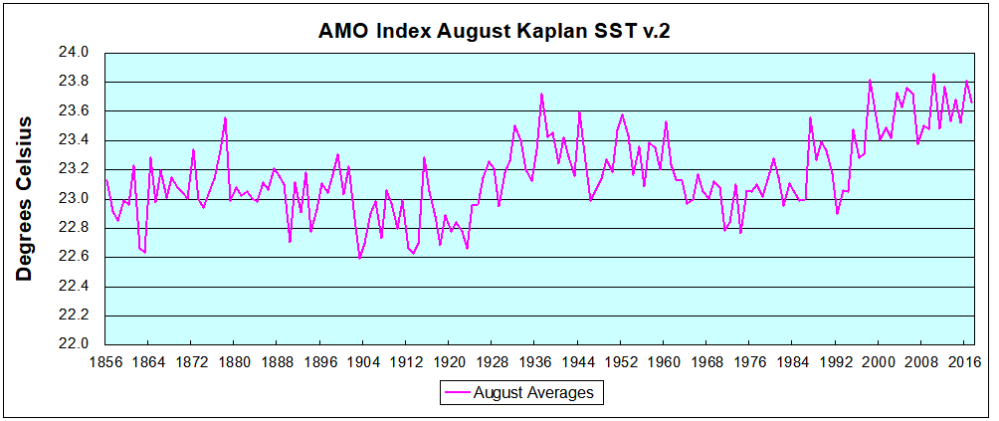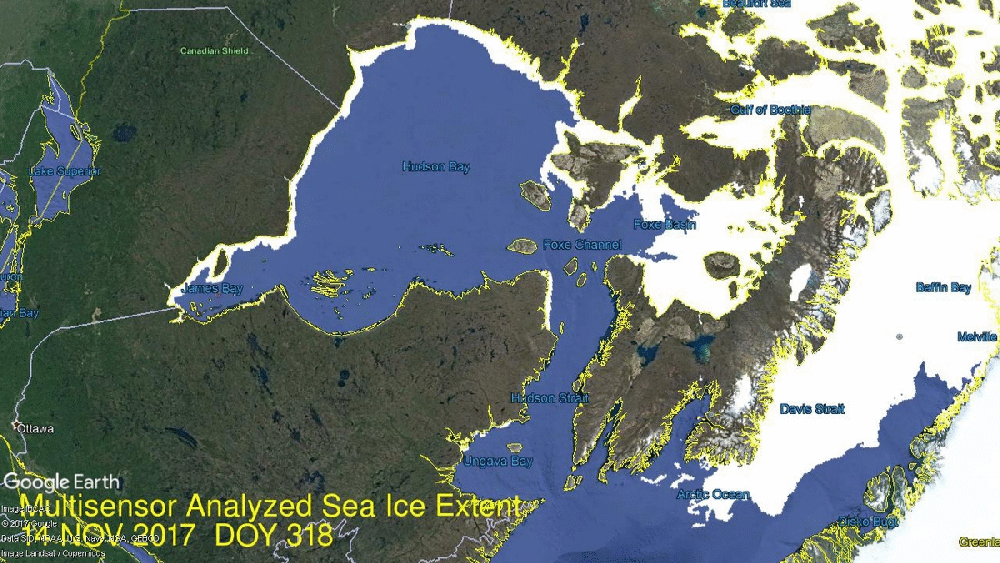 Recently I saw an activist website complaining that jurists were going to seminars led by staff at Antonin Scalia Law School, George Mason University. I wondered what might be on offer different than alarmist materials from Union of Concerned Scientists, National Resources Defense Council, Greenpeace, World Wildlife, and so on. So I went looking to see what was upsetting to the climate faithful, and found some unexpected resources for climate realists, including those serving on the bench.
Recently I saw an activist website complaining that jurists were going to seminars led by staff at Antonin Scalia Law School, George Mason University. I wondered what might be on offer different than alarmist materials from Union of Concerned Scientists, National Resources Defense Council, Greenpeace, World Wildlife, and so on. So I went looking to see what was upsetting to the climate faithful, and found some unexpected resources for climate realists, including those serving on the bench.
The Scalia Law School at George Mason University has a long standing Mason Judicial Education Program providing continuing education for jurists. The linked website provides this description:
For over four decades, the LEC’s Judicial Education Program has helped train the nation’s judges and justices in basic economics, accounting, statistics, regulatory analysis, and other related disciplines. The Program offers intellectually rigorous, balanced, and timely education programs to the nation’s judges and justices in the belief that the fundamental principles of a free and just society depend on a knowledgable and well educated judiciary. To date, over 5,000 federal and state judges from all 50 states and the District of Columbia, including three current U.S. Supreme Court Justices, have participated in at least one of the LEC’s judicial education programs. As one JEP participant has put it: the courses have “made us better at our work and improved the administration of justice.”
From time to time there are seminars where jurists discuss cases indicative of newer tendencies in litigation. The school publishes reports of these gatherings as well as studies and articles by legal scholars in its Journal of Law, Economics and Policy. This post relies on excerpts from several essays linked below.

The Basics of Climate Law
Readings in the Journal show that climate legalities are part of environmental law, which is an aspect of the Common Law dimension called Property Rights, in particular a tort called Public nuisance. As described by legal scholar Richard O. Faulk:
Public nuisance consists of a few elements, and they’re not very complicated. First of all, a public right must be involved—a right common to the general public that they have a legal right to enjoy. Second, there must be a substantial interference with that right that causes some sort of damage, or threatens to cause some sort of damage. Two remedies are available in public nuisance litigation. The first is an equitable remedy known as abatement, where a court can, upon finding a public nuisance, order the defendant to stop or to change its activities. The court can also order the defendant to remediate the problems caused by it. Under some circumstances, damages may be awarded. Costs of remediation and other compensatory awards may be available.

Woman on a ducking stool. Historical punishment for ‘common scold’ – woman considered a public nuisance. (Welsh/English heritage)
Let’s look at a couple of examples. I live in Houston. Let’s say that during Hurricane Ike a tree fell from my property and crashed into my neighbor’s house and damaged his roof. Under those circumstances, no public right is involved. Under those circumstances, it’s simply a private dispute between landowners. It may be private nuisance that he has a tree in his living room, but it’s a matter between us as private land owners, and a public nuisance does not arise.
But let’s say that the tree falls the other way and it blocks the street in front of my house. Under those circumstances, the public has a clear right to go down that road, to navigate it, to deal with whatever errands it needs to run. Since the fallen tree invades a right that’s common to everyone, it’s a public nuisance. The remedy is to order me to remove the tree.
Now, that’s a simple illustration. Let’s look at global warming. Let’s say, for example, that several utility companies in the Northeast burn coal in their plants. Those plants, through their smokestacks, release greenhouse gases—all kinds of things like carbon dioxide, methane, various other things as a result of the combustion of the coal. Let’s say that, for the purposes of argument, science has established that those types of emissions cause or contribute to cause global warming, which is a deleterious thing to human beings.

I don’t think anyone would doubt that the air we breathe is a common resource. So, there probably is a public right involved in these circumstances. But there are other issues. One of them is whether the emissions of these particular defendants are, in fact, substantially contributing or causing the climate change.
Generally in tort cases involving public nuisance, there is a term, which we all know from negligence cases and other torts, called proximate causation. In proximate causation, there is a “but for” test: but for the defendant’s activity, would the injury have happened? Can we say that climate change would not have happened if these power plants, these isolated five power plants, were not emitting greenhouse gases? If they completely stopped, would we still have global warming? If you shut them down completely and have them completely dismantled, would we still have global warming? Is it really their emissions that are causing this, or is it the other billions and billions of things on the planet that caused global warming—such as volcanoes? Such as gases being naturally released through earth actions, through off-gassing?
Is it the refinery down in Texas instead? Is it the elephant on the grasses in Africa? Is it my cows on my ranch in Texas who emit methane every day from their digestive systems? How can we characterize the public utilities’ actions as “but for” causes or “substantial contributions?” So far, the courts haven’t even reached these issues on the merits.
As Faulk says, the courts have not yet considered climate cases on their merits due to preemptive issues, such as standing, damages and liability. And there are additional hurdles before courts can rule on climate change.

What about the separation of constitutional powers?
Joseph F. Speelman:
The idea expressed by the National Resources Defense Counsel and other NGOs was that they didn’t like democracy because it didn’t get them what they wanted, and so they were going to use the courts to run the American political process— fundamentally anti-democratic philosophy that they have consistently maintained—and might I add—relatively successfully.
The theory of public nuisance the way it’s being utilized now, is simply lawlessness—nothing less than pure lawlessness. This is (stated by) the man that wrote the language on public nuisance, but never intended it to be used the way it is being used. It’s being used to try to change society. Is that the law’s job? Or is the law’s job to try to set standards so that people like me can advise clients on how they can obey the law? It’s so much fun to say, “Do the right thing.” What is the right thing?
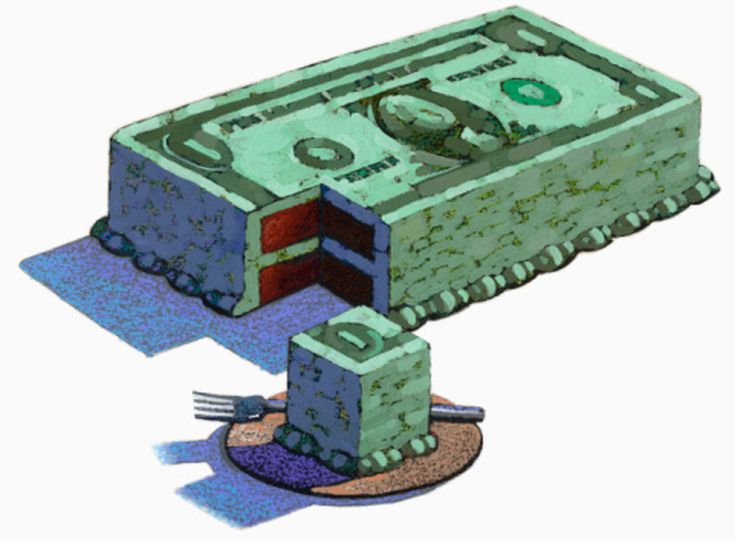
What about limits to liability?
About every two or three years, the people that brought you asbestos and tobacco come up with new ideas; predatory ideas. They’re designed to separate money from people that have it and take it somewhere else. So it is about the money. Now, try to explain that to your client. Put yourself in my posture. The only way I can safely advise a client to avoid liability in this environment is to not make, buy, sell, or insure anything—but that would make it really hard for us to do what the administration asks business to do, which is to hire people.
The circuit court deemed the theory of public nuisance, as it’s being utilized, standardless liability—no standards. No ability for Joe Speelman to advise his client on how to do the right thing to avoid liability. There are no standards. I can’t tell you how to do it. And if I can’t do that, then the entire process by which business operates and makes things and sells things in this country, ultimately comes down—we get to what we really have, which is a casino mentality. So, as I said when I started—from those folks that brought you asbestos, lead litigation, and tobacco—we now have climate change.

What about effective remedies?
Jason S. Johnson:
These are all interstate public nuisance cases. There are plaintiffs in some states suing defendants who, for the most part, are in other states. There is some overlap in some of the cases such as Comer and Kivalina, but generally, the interstate character of these public nuisance actions is very, very important.
Now, what’s the problem with externalization across states? One: it’s very likely that this is going to be an inefficient externalization. That is to say you come up with some award from the court, and the basic idea of economics is we use the liability system, to what? To internalize costs. If people bear the costs of their actions, they have an incentive then to take precautions or take various steps to lower the cost to other people of the actions that they take. The inefficiency of the externalization here is very, very likely. Why? Among other things, there are very real benefits from global warming that can be expected to benefit lots of states and lots of cities.
States that think they’re going to be beneficiaries, or think that they’re going to be real net losers from greenhouse gas emission reduction— because they’re states where a lot of electricity comes from burning coal and/or they mine and produce coal in those states—those states are not at the table in these litigations either. There are a lot of benefits and costs that are not included in this dyadic interstate public nuisance litigation. They’re almost sure to generate inefficient results. Another reason why they’re sure to generate inefficient results is because the benefit of any litigation depends upon the remedy affecting behavior, and behavior affecting the harm that people suffer.
It’s simply a fact that by 2020, China is going to be responsible— forget about India and Brazil—for about 45% of the world’s greenhouse gas emission reduction. So, there’s no remedy in any of these cases that will provide any relief to any of the plaintiffs.
Finally, what’s going to happen? Who knows what’s going to happen at the Supreme Court level. But these are likely to be very ineffective and counterproductive. Remember, for a lot of environmental groups, the reason for bringing these interstate public nuisance cases is they thought they were going to force Congress to act. Well, Congress didn’t act.
Excerpts above come from the Judicial Symposium on Civil Justice Issues: Climate Change Litigation
Climate Law Itself is Changing
A more recent symposium addressed a contextual shift in principles and assumptions, differing from older concepts underlying case law precedents from the past. Briefly put, the environment is no longer seen as static, but is rather dynamic at all time scales. And in parallel, the economic system is now recognized as dynamic and fluid, rather than determinative. Both of these paradigm shifts alter the way jurists and others consider environmental claims and responses to them.

Excerpts below come from Dynamic Ecology and Dynamic Economics,issue 11.2 in the Journal of Law, Economics and Policy
Jonathan H. Adler:
Most of today’s environmental laws and programs are based upon outmoded assumptions about the relative stability of natural systems when free of human interference. Scientists have understood for decades that ecosystems are anything but stable. To the contrary, ecosystems are incredibly dynamic and change over time due to both internal and external forces. An ecosystem is the “paradigmatic complex system,” exhibiting dynamic and discontinuous behavior. To be effective, therefore, environmental management systems must themselves be sufficiently adaptive.
Noted ecologist Daniel Botkin argues that “solving our environmental problems requires a new perspective” of environmental concerns that incorporates contemporary scientific understandings and embraces humanity’s role in environmental management. Recognizing a new perspective is but the first step, however. There is also a need to identify how this perspective can inform environmental policy, not just on the ground but in the very institutional architecture of environmental law and management. Then comes the really hard part, for even if it is possible to conceive of how environmental management should proceed, it may be devilishly difficult to put such ideas into practice. Old habits die hard. Legal and institutional norms die even harder.
Contemporary environmental law embodies archaic assumptions about the natural world. Through the middle of the 20th century, “the predominant theories in ecology either presumed or had as a necessary corollary a very strict concept of a highly structured, ordered, and regulated, steady state ecological system.” Under this view, nature naturally tended toward an equilibrium state—a “balance”—absent human interference. Maintaining and protecting this balance was, in this view, ecologically superior and ultimately better for humanity as well. Contemporary ecological science has “dismissed” these theories and the accompanying notion of a “balance of nature.”
The architecture of contemporary environmental law was erected when the equilibrium paradigm still held sway. As a consequence, the edifice of environmental law sits on an unstable foundation. The equilibrium paradigm justified “a wide range of prohibitions on human activities that alter ‘natural’ land and water systems” and other environmental restrictions on productive activity.
Contemporary ecological science embraces a more dynamic understanding of the natural world and rejects the idea of a “balance of nature” that would exist but for human interference. Two insights about natural systems are essential to the contemporary view. First is the recognition that ecological systems are always in flux. There is no true “natural” state for ecosystems. No “climax” or endpoint toward which ecosystems move or evolve if left undisturbed. Second, in this day and age, there is no part of the globe in which ecosystems exist wholly apart from human influence.
The environmental laws and regulations on the books are “out of date.” As Botkin observes, “whether or not environmental scientists know about geological time and evolutionary biology, their policies ignore them.” Too often environmental policy and protection measures are based upon “nonrational, ideological beliefs instead of rationally derived facts in harmony with modern understanding of the environment.” Yet, many of the most pressing environmental problems today “exhibit the hallmark characteristics of complex adaptive systems.”
Many existing environmental laws impose binary decisions on agencies—either a species is endangered or it is not, a level of pollution may be anticipated to endanger health or it is not, etc. Once such determinations are made, specific regulatory consequences follow automatically. If a species is endangered, it triggers the regulatory requirements of the Endangered Species Act (ESA). If a pollutant may be reasonably anticipated to threaten health and welfare, certain types of emission controls must be imposed.
Markets are also complex, adaptive, and dynamic systems. Just as it is not always possible to predict the ecological consequences of specific environmental management measures, it is often not possible to predict the market effects of such measures, or—perhaps more importantly—how such interventions will affect the interplay of economic decisions and environmental outcomes. Market actors will often respond to regulatory constraints in unanticipated ways, with unforeseen (and perhaps undesirable) effects.
There are opportunities to improve the adaptive and responsive nature of environmental protection efforts in the United States, but such opportunities are inherently limited so long as environmental protection is dominated by a relatively centralized, top-down administrative structure. Conventional regulatory and administrative systems are not particularly adaptive or responsive to changing environmental conditions, or even to changed understanding of environmental needs. Bureaucratic systems change slowly and are rarely forward looking. This is due, in part, to legal constraints, but also due to the nature of monopolistic bureaucratic systems, and the inherent information limitations that hamper the ability of such systems to acquire and account for relevant information—let alone to encourage the discovery of such information in the first place. Bureaucratic structures are resistant to change, and this is particularly true where such resistance poses few risks. Regulatory agencies do not go out of business when they fail to adapt. To the contrary, a failing agency is more likely to see a budget increase than it is to close its doors. The feedback mechanisms that force private firms to be adaptive and responsive to changing market conditions are largely absent from the administrative state.
So even if agency heads are willing to make the effort, they face a daunting gauntlet of interest group opposition and judicial scrutiny. According to Professor Ruhl, when the Fish and Wildlife Service (FWS) sought to integrate adaptive management into the habitat conservation plan (HCP) permitting process, interest group litigants and courts were quick to challenge the agency’s authority to incorporate greater flexibility into the program.
Due process concerns about adaptive management are greatest where federal agencies are engaged in the regulation of private land or the imposition of restrictions that directly affect private rights, including some rights on federal lands. Adopting adaptive management policies and techniques is far less problematic in the context of managing government lands than where environmental management decisions encroach upon private interests or risk infringing upon private property rights. While there may be political obstacles, including interest group resistance, to reducing the procedural obligations of agencies engaged in resource management decisions, there are less likely to be judicially cognizable property interests of the sort that could implicate Due Process concerns.
Climate Change Seen Through Dynamic Ecology
Daniel Botkin has led the shift in paradigm to Dynamic Ecology, especially in his influential book: Discordant Harmonies: a New Ecology for the Twenty-first Century. 1990 Oxford University Press, New York.

Daniel B. Botkin is Professor Emeritus, University of California, Santa Barbara, in the Department of Ecology, Evolution, and Marine Biology.
In 2014 he shared his view of the climate change issue in Testimony to the House Subcommittee on Science,Space and Technology. The whole document is enlightening, and included point-by-point critique of IPCC statements. His main points are highlighted below, while details and examples are in the full text.
1.I want to state up front that we have been living through a warming trend driven by a variety of influences. However, it is my view that this is not unusual, and contrary to the characterizations by the IPCC and the National Climate Assessment, these environmental changes are not apocalyptic nor irreversible.
2.My biggest concern is that both the reports present a number of speculative, and sometimes incomplete, conclusions embedded in language that gives them more scientific heft than they deserve. The reports are “scientific-sounding” rather than based on clearly settled facts or admitting their lack. Established facts about the global environment exist less often in science than laymen usually think.
3.HAS IT BEEN WARMING? Yes, we have been living through a warming trend, no doubt about that. The rate of change we are experiencing is also not unprecedented, and the “mystery” of the warming “plateau” simply indicates the inherent complexity of our global biosphere. Change is normal, life on Earth is inherently risky; it always has been. The two reports, however, makes it seem that environmental change is apocalyptic and irreversible. It is not.
4.IS CLIMATE CHANGE VERY UNUSUAL? No, it has always undergone changes.
5.ARE GREENHOUSE GASES INCREASING? Yes, CO2 rapidly.
6.IS THERE GOOD SCIENTIFIC RESEARCH ON CLIMATE CHANGE? Yes, a great deal of it.
7.ARE THERE GOOD SCIENTISTS INVOLVED IN THE IPCC 2014 REPORT? Yes, the lead author of the Terrestrial (land) Ecosystem Report is Richard Betts, a coauthor of one my scientific papers about forecasting effects of global warming on biodiversity.
8. ARE THERE SCIENTIFICALLY ACCURATE STATEMENTS AT PLACES IN THE REPORT? Yes, there are.
9. What I sought to learn was the overall take-away that the reports leave with a reader. I regret to say that I was left with the impression that the reports overestimate the danger from human-induced climate change and do not contribute to our ability to solve major environmental problems. I am afraid that an “agenda” permeates the reports, an implication that humans and our activity are necessarily bad and ought to be curtailed.
10. ARE THERE MAJOR PROBLEMS WITH THE REPORTS? Yes, in assumptions, use of data, and conclusions.
11. My biggest concern about the reports is that they present a number of speculative, and sometimes incomplete, conclusions embedded in language that gives them more scientific heft than they deserve. The reports, in other words, are “scientific-sounding,” rather than clearly settled and based on indisputable facts. Established facts about the global environment exist less often in science than laymen usually think.
12. The two reports assume and/or argue that the climate warming forecast by the global climate models is happening and will continue to happen and grow worse. Currently these predictions are way off the reality (Figure 1). Models, like all scientific theory, have to be tested against real-world observations. Experts in model validation say that the climate models frequently cited in the IPCC report are little if any validated. This means that as theory they are fundamentally scientifically unproven.
13. The reports suffer from using the term “climate change” with two meanings: natural and human-induced. These are both given as definitions in the IPCC report and are not distinguished in the text and therefore confuse a reader. (The Climate Change Assessment uses the term throughout including its title, but never defines it.) There are places in the reports where only the second meaning—human induced—makes sense, so that meaning has to be assumed. There are other places where either meaning could be applied.
14. Some of the report conclusions are the opposite of those given in articles cited in defense of those conclusions.
15. Some conclusions contradict and are ignorant of the best statistically valid observations.
16. The report for policy makers on Impacts, Adaptation, and Vulnerability repeats the assertion of previous IPCC reports that “large fraction of species” face “increase extinction risks” (p15). Overwhelming evidence contradicts this assertion. And it has been clearly shown that models used to make these forecasts, such as climate envelope models and species-area curve models, make incorrect assumptions that lead to erroneous conclusions, over-estimating extinction risks. Surprisingly few species became extinct during the past 2.5 million years, a period encompassing several ice ages and warm periods.
17. THE REPORT GIVES THE IMPRESSION THAT LIVING THINGS ARE FRAGILE AND RIGID, unable to deal with change. The opposite is to case. Life is persistent, adaptable, adjustable.
18. STEADY-STATE ASSUMPTION: There is an overall assumption in the IPCC 2014 report and the Climate Change Assessment that all change is negative and undesirable; that it is ecologically and evolutionarily unnatural, bad for populations, species, ecosystems, for all life on planet Earth, including people. This is the opposite of the reality.
19. The summary for policy makers on Impacts, Adaptation, and Vulnerability makes repeated use of the term “irreversible” changes. A species going extinct is irreversible, but little else about the environment is irreversible.
20. The extreme overemphasis on human-induced global warming has taken our attention away from many environmental issues that used to be front and center but have been pretty much ignored in the 21st century.
21. Do the problems with these reports mean that we can or should abandon any concerns about global warming or abandon any research about it? Certainly not, but we need to put this issue within an appropriate priority with other major here-and-now environmental issues that are having immediate effects.
22. The concerns I have mentioned with the IPCC apply as well to the White House’s National Climate Assessment.

Summary
The good news: Some people in the legal community are reflecting analytically about climate claims appearing in litigation, and are speaking out about the failure of facts and logic to support the allegations.
The bad news: The more I read, the more I fear the judiciary is caught in the past and ill-prepared for the onslaught of cases coming from the anti-fossil fuels activists. Jason Johnson, one of the above presenters said this on his website:
Legal scholarship has come to accept as true the various pronouncements of the Intergovernmental Panel on Climate Change (IPCC) and other scientists who have been active in the movement for greenhouse gas (ghg) emission reductions to combat global warming. The only criticism that legal scholars have had of the story told by this group of activist scientists – what may be called the climate establishment – is that it is too conservative in not paying enough attention to possible catastrophic harm from potentially very high temperature increases.
Scientists who have been leaders in the process of producing these Assessment Reports (“AR’s”) argue that they provide a “balanced perspective” on the “state of the art” in climate science,with the IPCC acting as a rigorous and “objective assessor” of what is known and unknown in climate science. Legal scholars have accepted this characterization, trusting that the IPCC AR’s are the product of an “exhaustive review process” – involving hundreds of outside reviewers and thousands of comments. Within mainstream environmental law scholarship, the only concern expressed about the IPCC and “consensus” climate change science is that the IPCC’s process has allowed for too much government influence (especially from China and the U.S.), pressure that has caused the IPCC’s future projections to be too cautious – too hesitant to confidently project truly catastrophic climate change.
Thus politicians, environmental law scholars and policymakers have clearly come to have extreme confidence in the opinion of a group of scientists – many of whom play a leading role on the IPCC – who hold that the late twentieth century warming trend in average global surface temperature was caused by the buildup of anthropogenic ghg’s, and that if ghg emissions are not reduced soon, then the 21st century may witness truly catastrophic changes in the earth’s climate. In the legal and the policy literature on global warming, this view – which may be called the opinion of the climate establishment – is taken as a fixed, unalterable truth. It is virtually impossible to find anywhere in the legal or the policy literature on global warming anything like a sustained discussion of the actual state of the scientific literature on ghg emissions and climate change. Instead, legal and policy scholars simply defer to a very general statement of the climate establishment’s opinion (except when it seems too conservative), generally failing even to mention work questioning the establishment climate story, unless to dismiss it with the ad hominem argument that such work is the product of untrustworthy, industry-funded “skeptics” and “deniers.”
This paper constitutes such a cross-examination. As anyone who has served as an expert witness in American litigation can attest, even though an opposing attorney may not have the expert’s scientific training, a well prepared and highly motivated trial attorney who has learned something about the technical literature can ask very tough questions, questions that force the expert to clarify the basis for his or her opinion, to explain her interpretation of the literature, and to account for any apparently conflicting literature that is not discussed in the expert report. My strategy in this paper is to adopt the approach that would be taken by a non-scientist attorney deposing global warming scientists serving as experts for the position that anthropogenic ghg emissions have caused recent global warming and must be halted if serious and seriously harmful future warming is to be prevented – what I have called above the established climate story.
To use legal terms, is the work by the IPCC and establishment story lead scientists a legal brief – intended to persuade – or a legal memo – intended to objectively assess both sides? The second and related objective of this Article is to use the cross examination to identify what seem to be the key, policy-relevant areas of remaining uncertainty in climate science, and to then at least begin to sketch the concrete implications of such remaining uncertainty for the design of legal rules and institutions adopted to respond to perceived climate change risks.
Far from turning up empty, my cross examination has (initially, to my surprise) revealed that on virtually every major issue in climate change science, the IPCC AR’s and other summarizing work by leading climate establishment scientists have adopted various rhetorical strategies that seem to systematically conceal or minimize what appear to be fundamental scientific uncertainties or even disagreements. The bulk of this paper proceeds by cataloguing, and illustrating with concrete climate science examples, the various rhetorical techniques employed by the IPCC and other climate change scientist/advocates in an attempt to bolster their position, and to minimize or ignore conflicting scientific evidence.
There are, to be sure, many chapters in the IPCC Assessment Reports whose authors have chosen to quite fully disclose both what is known as well as what is unknown, and subject to fundamental uncertainty, in their particular field of climate science. Still, the climate establishment story — comprising all of the IPCC Assessment Reports, plus the IPCC’s “Policymaker Summaries,” plus the freelance advocacy efforts of activist climate scientists (exemplified by James Hansen of NASA) – seems overall to comprise an effort to marshal evidence in favor of a predetermined policy preference, rather than to objectively assess both what is known and unknown about climatic variation and its causes.
To his credit Jason Johnson has done his homework on Climate Science and you can see his results in the document Global Warming Advocacy Science: A Cross Examination
How many other jurists have girded themselves for this battleground?







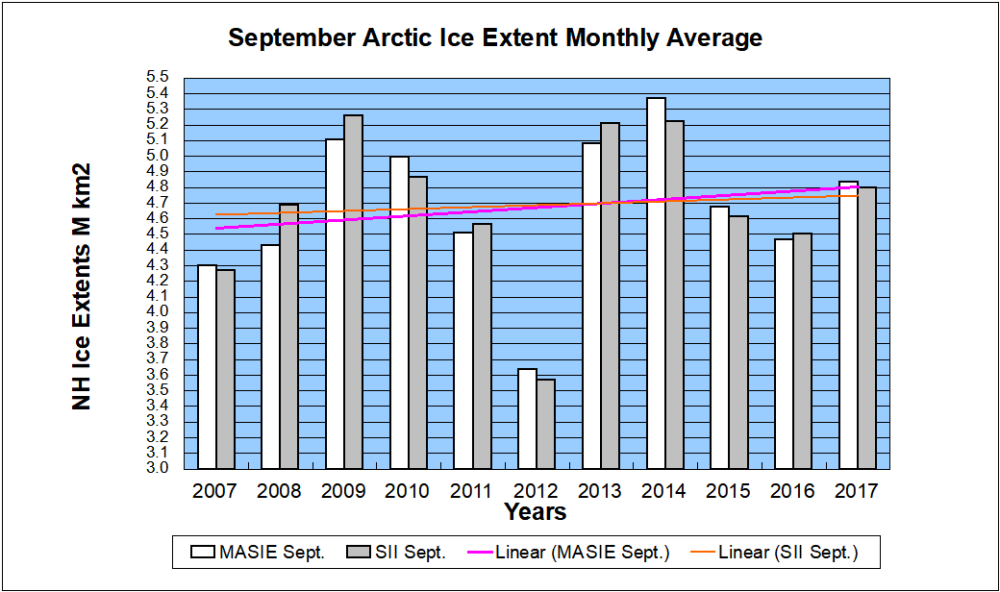 More details at
More details at  The AAs (Arctic Alarmists) are putting their faith in the BBs (Barents and Bering), the only two basins below average this year. Both are marginal to the Arctic Ocean and both are heavily affected by human marine activities, including shipping, navies, fishing, tourism and sea floor extraction.
The AAs (Arctic Alarmists) are putting their faith in the BBs (Barents and Bering), the only two basins below average this year. Both are marginal to the Arctic Ocean and both are heavily affected by human marine activities, including shipping, navies, fishing, tourism and sea floor extraction.





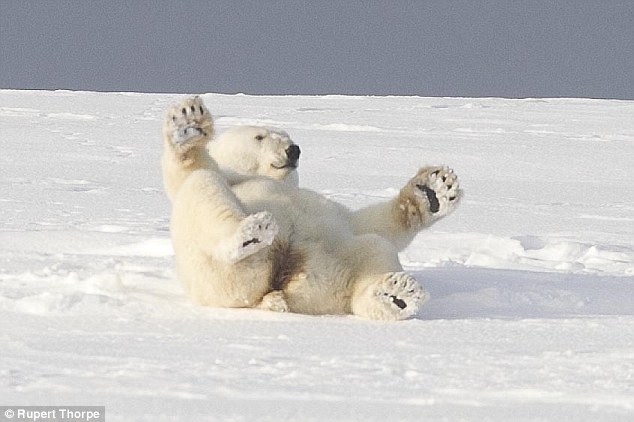

















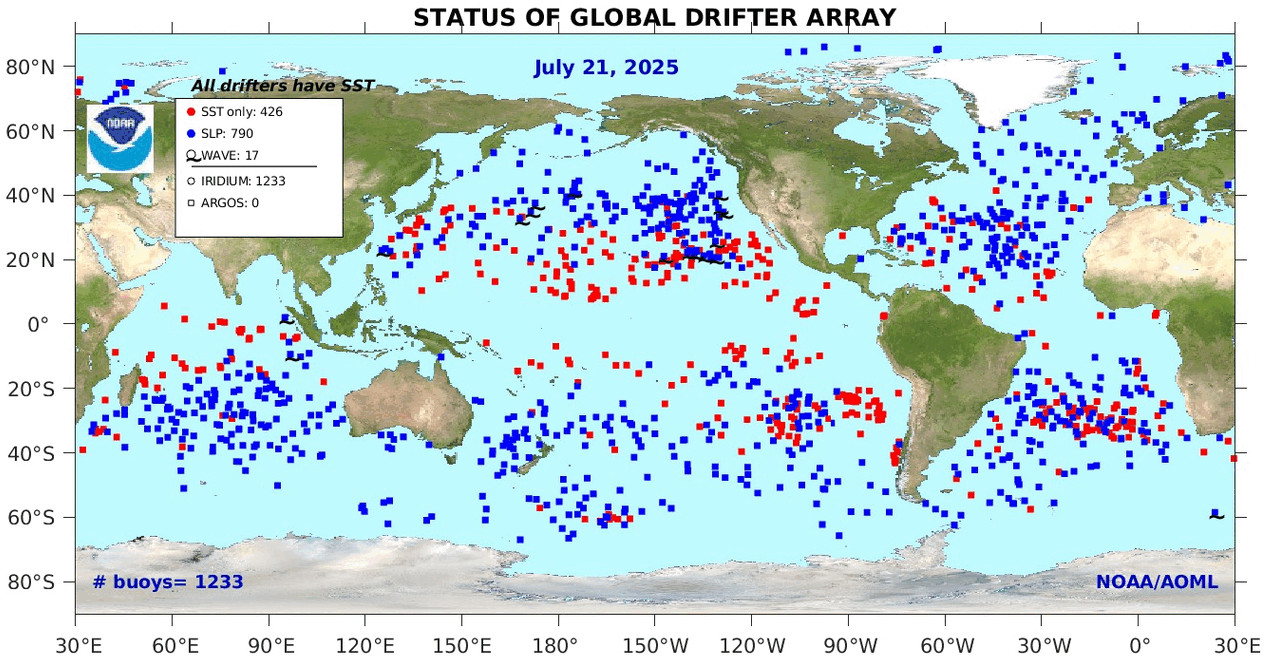
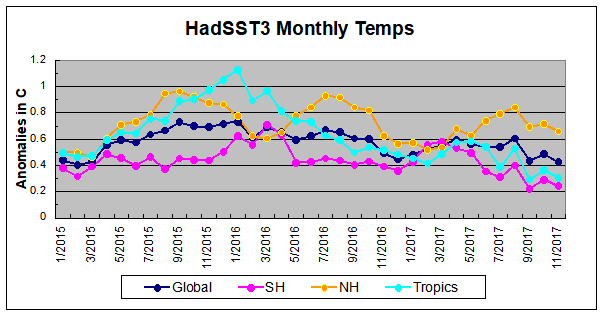

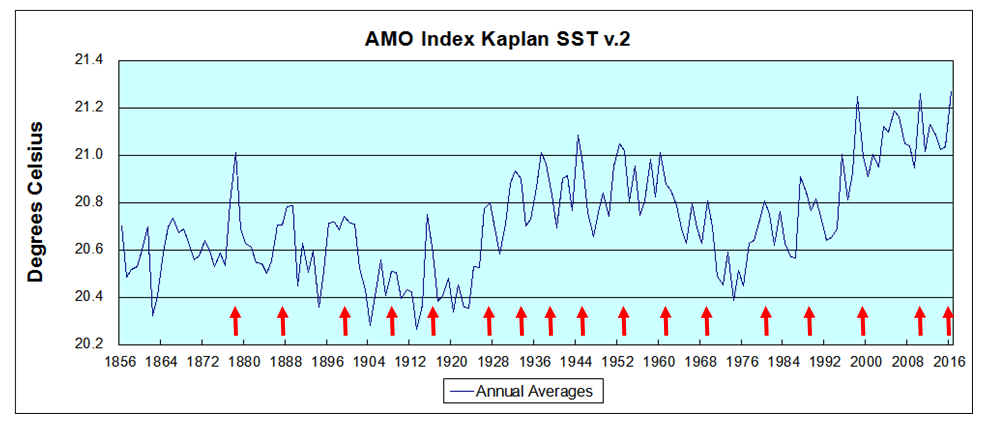 The data is annual averages of absolute SSTs measured in the North Atlantic. The significance of the pulses for weather forecasting is discussed in
The data is annual averages of absolute SSTs measured in the North Atlantic. The significance of the pulses for weather forecasting is discussed in 